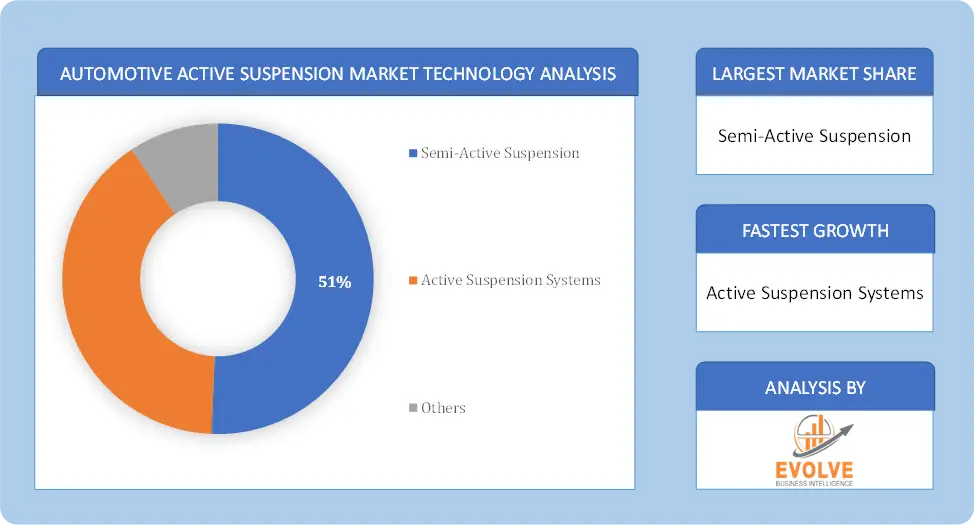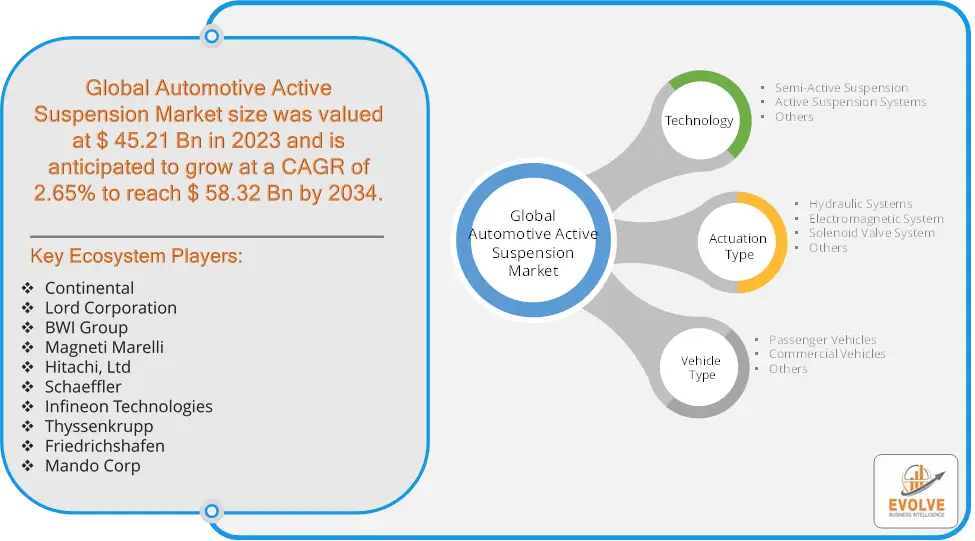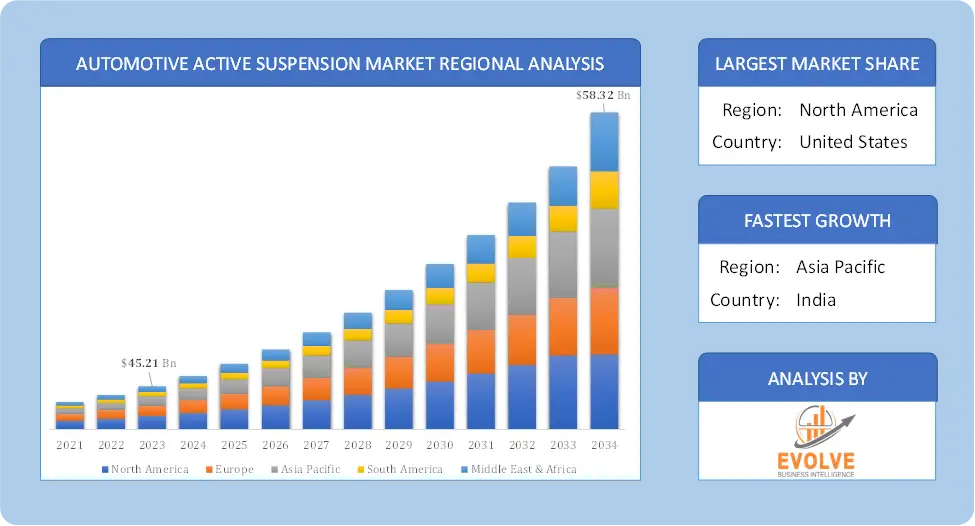Automotive Active Suspension Market Overview
The Automotive Active Suspension Market size accounted for USD 45.21 Billion in 2023 and is estimated to account for 46.74 Billion in 2024. The Market is expected to reach USD 58.32 Billion by 2034 growing at a compound annual growth rate (CAGR) of 2.65% from 2024 to 2034. Automotive active suspension is a technology that uses electronic control systems to adjust a vehicle’s suspension components in real-time, providing superior ride comfort, handling, and stability compared to traditional passive suspensions. Unlike passive suspensions that rely solely on springs and shock absorbers, active suspensions employ actuators (hydraulic, pneumatic, or electric) to continuously adjust the suspension’s stiffness and damping characteristics based on road conditions and vehicle dynamics.
The automotive active suspension market has been growing steadily due to advancements in technology, increasing consumer demand for comfort and safety, and the integration of active suspensions into electric vehicles.
Global Automotive Active Suspension Market Synopsis
 Automotive Active Suspension Market Dynamics
Automotive Active Suspension Market Dynamics
The major factors that have impacted the growth of Automotive Active Suspension Market are as follows:
Drivers:
Ø Technological Advancements
Innovations in sensor and actuator technology have made active suspension systems more reliable and effective, encouraging adoption in various vehicle segments. Active suspension systems can improve vehicle stability and control, contributing to overall safety. This is particularly important for high-speed driving and challenging road conditions. The compatibility of active suspension systems with ADAS enhances vehicle dynamics, making them more attractive for manufacturers looking to integrate multiple safety and performance features.
Restraint:
- Perception of High Costs and Market Variability
Active suspension systems are typically more expensive to design and manufacture than traditional passive systems, which can deter consumers and manufacturers, particularly in lower-end vehicle segments. The market for active suspension systems can be influenced by broader economic conditions, consumer preferences, and automotive industry trends, leading to variability in demand.
Opportunity:
⮚ Advancements in Autonomous Driving
The development of autonomous vehicles requires sophisticated suspension systems that can adapt to varying driving conditions, providing opportunities for active suspension technology to play a critical role. Manufacturers are looking for ways to improve vehicle efficiency and reduce emissions. Active suspension systems can contribute to better aerodynamics and improved energy consumption in EVs. Expanding automotive markets in developing regions present growth opportunities, particularly as consumers become more aware of and demand advanced vehicle technologies.
Automotive Active Suspension Market Segment Overview
By Technology
 Based on Technology, the market is segmented based on Semi-Active Suspension, Active Suspension Systems and Others. The Semi-Active Suspension segment dominant the market.
Based on Technology, the market is segmented based on Semi-Active Suspension, Active Suspension Systems and Others. The Semi-Active Suspension segment dominant the market.
By Actuation Type
Based on Actuation Type, the market segment has been divided into Hydraulic Systems, Electromagnetic System, Solenoid Valve System and Others. The hydraulic segment dominate the market. In the global automotive industry, hydraulic damper suspension systems are widely employed. This device not only provides self-leveling and height adjustment capabilities but also aids in increasing a vehicle’s aerodynamic performance when traveling at high speeds.
By Vehicle Type
Based on Vehicle Type, the market segment has been divided into Passenger Vehicles, Commercial Vehicles and Others. The passenger vehicle segment dominant the market. A passenger automobile is a road vehicle designed to transport passengers and has a maximum seating capacity of nine people. If the total number of seats is less than ten, microcars, taxis, and other hired passenger cars are included in the term passenger car.
Global Automotive Active Suspension Market Regional Analysis
Based on region, the global Automotive Active Suspension Market has been divided into North America, Europe, Asia-Pacific, the Middle East & Africa, and Latin America. North America is projected to dominate the use of the Automotive Active Suspension Market followed by the Asia-Pacific and Europe regions.
 Automotive Active Suspension North America Market
Automotive Active Suspension North America Market
North America holds a dominant position in the Automotive Active Suspension Market. United States is a major market for active suspension systems, driven by the presence of leading automotive manufacturers and a strong demand for premium vehicles. Strong demand for luxury and performance vehicles, coupled with advancements in automotive technology. Many leading automotive manufacturers and suppliers are based here, driving innovation and adoption of active suspension systems and increasing investments in electric vehicles and advanced driver-assistance systems (ADAS).
Automotive Active Suspension Asia-Pacific Market
The Asia-Pacific region has indeed emerged as the fastest-growing market for the Automotive Active Suspension Market industry. Rapidly growing automotive market, particularly in countries like China, Japan, and South Korea. Numerous local and international manufacturers are investing in advanced suspension technologies and the world’s largest automotive market, with rapidly increasing demand for active suspension systems, particularly in luxury and premium vehicles.
Competitive Landscape
The global Automotive Active Suspension Market is highly competitive, with numerous players offering a wide range of software solutions. The competitive landscape is characterized by the presence of established companies, as well as emerging startups and niche players. To increase their market position and attract a wide consumer base, the businesses are employing various strategies, such as product launches, and strategic alliances.
Prominent Players:
- Continental
- Lord Corporation
- BWI Group
- Magneti Marelli
- Hitachi, Ltd
- Schaeffler
- Infineon Technologies
- Thyssenkrupp
- Friedrichshafen
- Mando Corp
Key Development
In April 2023– ZF Friedrichshafen AG reported opening a new research and development center for car suspension systems. The center is in the United States, and its main job will be creating new self-driving car technologies.
In May 2023– Hitachi Ltd. said that it had made a new type of active suspension system that uses artificial intelligence. The new system is meant to make the ride more comfortable and improve the way the car handles in all driving situations.
Scope of the Report
Global Automotive Active Suspension Market, by Technology
- Semi-Active Suspension
- Active Suspension Systems
- Others
Global Automotive Active Suspension Market, by Actuation Type
- Hydraulic Systems
- Electromagnetic System
- Solenoid Valve System
- Others
Global Automotive Active Suspension Market, by Vehicle Type
- Passenger Vehicles
- Commercial Vehicles
- Others
Global Automotive Active Suspension Market, by Region
- North America
- US
- Canada
- Mexico
- Europe
- UK
- Germany
- France
- Italy
- Spain
- Benelux
- Nordic
- Rest of Europe
- Asia Pacific
- China
- Japan
- South Korea
- Indonesia
- Austalia
- Malaysia
- India
- Rest of Asia Pacific
- South America
- Brazil
- Argentina
- Rest of South America
- Middle East & Africa
- Saudi Arabia
- UAE
- Egypt
- South Africa
- Rest of Middle East & Africa
| Parameters | Indicators |
|---|---|
| Market Size | 2033: $58.32 Billion |
| CAGR | 2.65% CAGR (2023-2033) |
| Base year | 2022 |
| Forecast Period | 2023-2033 |
| Historical Data | 2021 |
| Report Coverage | Revenue Forecast, Competitive Landscape, Growth Factors, and Trends |
| Key Segmentations | Technology, Actuation Type, Vehicle type |
| Geographies Covered | North America, Europe, Asia-Pacific, Latin America, Middle East, Africa |
| Key Vendors | Continental, Lord Corporation, BWI Group, Magneti Marelli, Hitachi, Ltd, Schaeffler, Infineon Technologies, Thyssenkrupp, Friedrichshafen and Mando Corp |
| Key Market Opportunities | • Advancements in Autonomous Driving • Increased Focus on Sustainability |
| Key Market Drivers | • Technological Advancements • Focus on Safety and Advanced Driver-Assistance Systems (ADAS) |
REPORT CONTENT BRIEF:
- High-level analysis of the current and future Automotive Active Suspension Market trends and opportunities
- Detailed analysis of current market drivers, restraining factors, and opportunities in the future
- Automotive Active Suspension Market historical market size for the year 2021, and forecast from 2023 to 2033
- Automotive Active Suspension Market share analysis at each product level
- Competitor analysis with detailed insight into its product segment, Government & Defense strength, and strategies adopted.
- Identifies key strategies adopted including product launches and developments, mergers and acquisitions, joint ventures, collaborations, and partnerships as well as funding taken and investment done, among others.
- To identify and understand the various factors involved in the global Automotive Active Suspension Market affected by the pandemic
- To provide a detailed insight into the major companies operating in the market. The profiling will include the Government & Defense health of the company’s past 2-3 years with segmental and regional revenue breakup, product offering, recent developments, SWOT analysis, and key strategies.







